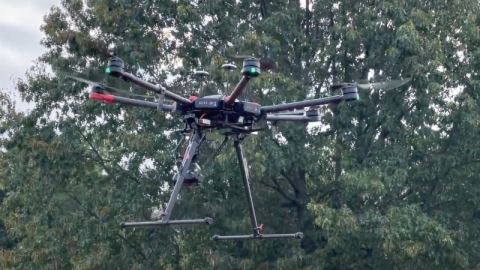Leveraging Drone Flight Services for Your City
Every month the city of Winchester, Virginia floats millions of dollars worth of water to its residents. This water is billed in a bi-monthly cycle, with residents paying for the last two weeks of water they used in each bill.
The catch? To know how much to charge, the city has to send out people from its Utility department to read each person’s water meter manually.
To take these readings, city employees must drive slowly through the neighborhoods of Winchester with a handheld device, recording water meter usage data as they go. The approach is slow and time-consuming, but it’s the only way the city can collect the data it needs to know how much to bill residents for their water usage.
What If Water Meter Readings Could Be Done by Drone?
When Winchester became the first city to partner with DroneUp for its Innovative Municipalities Project, water meter readings were one of the main pain points that city leadership was interested in addressing.
City administrators wanted to know whether the current manual process of reading meters could be sped up by using drones to carry the meter reader, flying from house to house, and collecting data instead of driving.
After an in-depth planning period, the water meter reading initiative became the first of a series of five tests that DroneUp planned for the city to investigate different ways it could use drones in its work. Additional tests will be posted in this series over the next several weeks.
The primary goal of this test was to see if a drone could be used to collect water meter data at all—to the best of the DroneUp’s team’s knowledge, a drone had never before been used to collect water meter data before, so just proving that it was possible would be a successful outcome for the test.
The Results from the Water Meter Test
To test the idea, the DroneUp team retrofitted a Matrice 600 with a handheld water meter reader called a Trimble Ranger 3XE.
The water meter test took place on a Monday, starting at 10 AM, when most of the city’s residents would either be at work or at school.
That morning the DroneUp team sent Winchester leadership a flight plan along with a risk assessment that included the day’s schedule and the weather forecast. As the team was performing its test, a live Operations Map showed where they had planned to set up, take off, and fly and where they planned to place visual observers so that city stakeholders could have insight into the details of the day’s mission.
The water meter test took place over a period of about three hours, with a DroneUp pilot flying the Matrice 600 through a pre-established area, bringing it close enough to each resident’s water meter so that the handheld reader could collect usage data.
The pilot flew the drone through a small sample area, collecting water meter data as it went, then brought it back to the launch point to confirm that the data it had collected was accurate. After that short flight, the DroneUp team flew the remainder of the residential area selected for the test, collecting water meter data for the remaining homes there.
The results?
The test worked! The drone collected accurate water meter data remotely, proving that the idea could improve the way the city collects its water meter data.
What’s Next?
The DroneUp team proposed to optimize the water meter readings to include:
- Create a live map to show the drone’s water meter data collection status in real-time.
- Optimize the route(s) that the drone flies while collecting water meter data.
- Use autonomous flight to make the process more efficient.
The water meter test is just one example of how drones have the potential to help both public utilities and private companies make their work quicker, safer, and less expensive.
Inspectors in various industries have been using drones equipped with sophisticated cameras to collect data remotely for years now, helping them improve safety and increase speed in their data collection work.
In private companies, drones are being used in various ways, from inspecting cell towers to helping insurance adjusters speed up their claims processing.
And in cities, drones are being used to conduct wastewater inspections inside large pipes and to inspect bridges, not to mention a growing list of new applications, such as the water meter test DroneUp recently conducted.
About DroneUp’s Innovative Municipalities Project
The Innovative Municipalities Project is an initiative created by DroneUp to offer drone flight services to cities to help them become more efficient while realizing significant savings.
The project’s core focus is to test how drones can help cities improve their work from one day to the next by leveraging drone technology.
Through close collaborations between DroneUp and city governments, project leaders identify and test custom-built solutions for each city’s unique need to employ advanced drones and software to help cities save money, improve efficiency, and, in some instances, keep people out of harm’s way.
Learn more about DroneUp’s Innovative Municipalities Project by connecting with us at [email protected].
